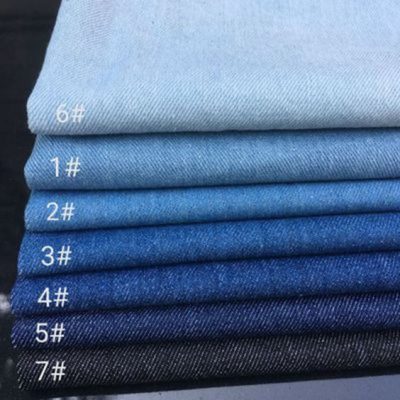Denim Fabric Construction, Types, Properties, Uses
In addition to jeans, Denim is also one of the preferred choices for young people every time they go shopping. So, what is denim fabric that garners such praise from everyone? Let’s explore it further with Denim Fabric: Denim Fabric Construction, Types, Properties, Uses
What is Denim fabric?

Denim is a rugged, durable fabric woven securely from 100% cotton. To create this type of fabric, a twill weave pattern is used, involving the interweaving of multiple white and indigo (blue) threads. The indigo threads run vertically, while the white threads run horizontally.
Occasionally, denim fabric may incorporate polyester or Lycra threads to prevent shrinkage and wrinkles. Traditional denim is dyed blue due to the use of indigo dye. The density of the denim fabric’s threads is high, resulting in a stiff texture when touched.
The distinctive feature of this fashion fabric is the visible diagonal lines on its surface. These lines can be easily distinguished from other types of cotton fabrics, making it truly unique. “𝐖𝐨𝐯𝐞𝐧 𝐈𝐝𝐞𝐧𝐭𝐢𝐭𝐢𝐞𝐬”: 𝐅𝐚𝐛𝐫𝐢𝐜 𝐂𝐡𝐨𝐢𝐜𝐞𝐬 𝐚𝐧𝐝 𝐡𝐨𝐰 𝐭𝐨 𝐝𝐢𝐬𝐭𝐢𝐧𝐠𝐮𝐢𝐬𝐡 𝐭𝐨𝐝𝐚𝐲’𝐬 𝐟𝐚𝐛𝐫𝐢𝐜𝐬.
Origin of Denim fabric
The type of denim fabric, known as “Serge de Nîmes,” originates from the 17th century in a beautiful French town called Nîmes. It wasn’t until the 1850s that denim fabric made its appearance in the United States.
The miners in the Wild West were particularly fond of durable protective clothing made from denim fabric. According to tradition, denim fabric is dyed blue using indigo dye.
Types of Denim fabric
- Dry Denim, Also known as raw denim, is a type of denim fabric that is dyed in a deep blue color without any washing process to set the dye. As a result, it often fades when washed. Many people prefer not to wash garments made from this material because they are concerned about the color fading and the potential loss of the garment’s shape.
- Raw denim, also known as “unwashed denim” or “dry denim,” is a type of denim fabric that has not undergone any washing or pre-treatment after the dyeing process. The absence of washing is intentional, as it allows the denim to retain its deep, rich color and stiffness. Typically, washing denim is done to make it softer and to remove any shrinkage.
- Selvedge denim, also known as “selvage denim” or “self-edge denim,” is a type of denim fabric that is characterized by its tightly woven edges. These edges typically have a distinctive white, non-dyed strip running along them. This strip is created during the weaving process and is used to reinforce the fabric’s edges. https://leartex.com/denim-fabric-construction-types-properties-and-uses/
Properties of Denim fabric
- Weight: Traditionally, denim is a weighty material, due to the thickness of the fabric. Heavier fabrics are likely to become jeans and jackets, whereas more lightweight denim is now used to make skirts, dresses, and shirts.
- Thickness: The strands of cotton are woven tightly to provide protection and prevent a tear.
- Stiffness: As seen above, how stiff your denim jeans or clothing is will depend on the type of denim – raw denim will be quite stiff whereas mid-wash denim fabric properties make it softer.
Uses of Denim fabric
Denim fabric is used to make clothes that can be used all year round, especially long pants. In addition, denim fabric is also used to make costumes such as:
- Jacket
- Shirt
- Vest
- Set set
- Bibs
- Skirt
- Shorts
- Sewing accessories
Email: lyd@igreentex.com
WhatsApp/ Viber/ Zalo .No: +84938.045.900
We have all international shipping line to all countries.